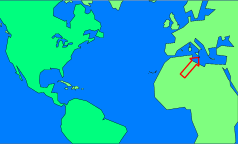 Another late holiday in the way of an attractive package offering a week in
Valletta, the capital of Malta. Malta is an historic island in the middle of
the Mediterranean and is quite unique because it has it's own culture and
language, quite distinct from its near neighbours. It's had connections with
the UK for
a very long time, and during World War II was
awarded the George Medal, the UK's highest decoration for civilian valour and
bravery.
Another late holiday in the way of an attractive package offering a week in
Valletta, the capital of Malta. Malta is an historic island in the middle of
the Mediterranean and is quite unique because it has it's own culture and
language, quite distinct from its near neighbours. It's had connections with
the UK for
a very long time, and during World War II was
awarded the George Medal, the UK's highest decoration for civilian valour and
bravery.
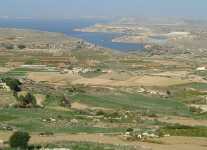 Most Maltese speak English as a second language, and
the English are welcome. The weather is very Mediterranean (obviously), and is
hot and sunny most of the time, February and March are perhaps the worst
weather, July and August get too hot to be comfortable, October/November is
about right. Most Maltese speak English as a second language, and
the English are welcome. The weather is very Mediterranean (obviously), and is
hot and sunny most of the time, February and March are perhaps the worst
weather, July and August get too hot to be comfortable, October/November is
about right.
We're flying from Gatwick this time. Gatwick isn't the easiest airport to get to
if you don't take
a car. But I've found these internet sites which sell airport parking at a
fraction of the regular price, so
I've got the car parked in the Gatwick long term without it costing an arm
and a leg.
Three hours to Gatwick??
It's a 10:30 flight, but I admit it - old age is creeping up on me, I still don't know how I
managed to miscalculate the start time. But once out of bed, we might as well
set off an hour early. It normally takes an hour 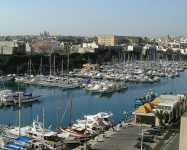 and a bit to get to
Gatwick, and it's a nice fast
run round the M25 and M23 at that time in the morning. Into the car, and off
we go - it seems a bit puddley,
and it's obviously been raining. Also there's all these rumours about
global warming, but up to now, I can't say I've noticed. But the M25 closed
due to flooding - you've got to be kidding! Three and a half hours later and having
detoured round half of Southern England we roll into the car park, with only
20 minutes spare. Then a mad rush to check-in, to be told that we're
amongst the first to make it, and anyway, the runway is in danger of sinking under
the volume of water, so all flights are delayed for at least an hour. This must be the one time I've been
grateful for airport delays. Then someone else appears and tells us all local traffic round
Gatwick is grid-locked, and even the airport hotels are telling their
customers to walk as the shuttles are lost somewhere in the mess. and a bit to get to
Gatwick, and it's a nice fast
run round the M25 and M23 at that time in the morning. Into the car, and off
we go - it seems a bit puddley,
and it's obviously been raining. Also there's all these rumours about
global warming, but up to now, I can't say I've noticed. But the M25 closed
due to flooding - you've got to be kidding! Three and a half hours later and having
detoured round half of Southern England we roll into the car park, with only
20 minutes spare. Then a mad rush to check-in, to be told that we're
amongst the first to make it, and anyway, the runway is in danger of sinking under
the volume of water, so all flights are delayed for at least an hour. This must be the one time I've been
grateful for airport delays. Then someone else appears and tells us all local traffic round
Gatwick is grid-locked, and even the airport hotels are telling their
customers to walk as the shuttles are lost somewhere in the mess.
The Hotel
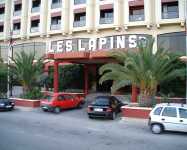 What
with the delays in the UK, the two and a half hour flight time and the change in time
zones, it's late afternoon by the time we're settled in. The Hotel les Lapins
- the significance of rabbits was lost on me at the time - is a What
with the delays in the UK, the two and a half hour flight time and the change in time
zones, it's late afternoon by the time we're settled in. The Hotel les Lapins
- the significance of rabbits was lost on me at the time - is a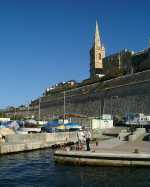 large block,
about 20 years old, built on the harbour quay at Msida, opposite Valletta. The
hotel is pretty good, the rooms large and comfortable, a large lounge and bar,
two restaurants and everything else you might expect. If it has a fault, it's
a bit big and impersonal. It's
been
bought by the Best Western group sometime recently, and it seemed to have trouble fitting into
the American corporate mould, it's struggling to retain its Englishness. I
can't complain, I've spent a lot of time in Best Westerns and they are bit
'samey' and plastic. Any non-conformity has to be a good thing. large block,
about 20 years old, built on the harbour quay at Msida, opposite Valletta. The
hotel is pretty good, the rooms large and comfortable, a large lounge and bar,
two restaurants and everything else you might expect. If it has a fault, it's
a bit big and impersonal. It's
been
bought by the Best Western group sometime recently, and it seemed to have trouble fitting into
the American corporate mould, it's struggling to retain its Englishness. I
can't complain, I've spent a lot of time in Best Westerns and they are bit
'samey' and plastic. Any non-conformity has to be a good thing.
So where to go?
Just about everywhere. Take the capital, Valletta, most of it is perched high
on a large rocky outcrop,
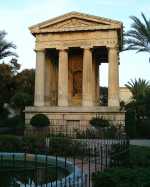 with
surprisingly steep roads down to sea level. The whole place is a rabbit warren
(that word again) of narrow streets and shady alleys. It reeks of age and
history - and a few less savoury things as well - the Maltese seem to favour
small yappy dogs as pets, and there isn't much green space in the middle of
Valletta. Just watch where you're treading is all. Every turn reveals
something interesting and different, little museums, big museums, ancient
buildings, the Malta Experience (well worth going to), churches, cafes
spilling out into the streets. There's small and neat public gardens,
unexpected views, you name it. Although it's small and compact, you could
spend days walking round Valletta, partly because it's interesting, and partly
because you're lost. with
surprisingly steep roads down to sea level. The whole place is a rabbit warren
(that word again) of narrow streets and shady alleys. It reeks of age and
history - and a few less savoury things as well - the Maltese seem to favour
small yappy dogs as pets, and there isn't much green space in the middle of
Valletta. Just watch where you're treading is all. Every turn reveals
something interesting and different, little museums, big museums, ancient
buildings, the Malta Experience (well worth going to), churches, cafes
spilling out into the streets. There's small and neat public gardens,
unexpected views, you name it. Although it's small and compact, you could
spend days walking round Valletta, partly because it's interesting, and partly
because you're lost.
Transport
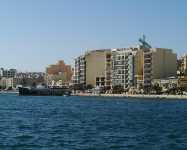 Getting
around is an experience in itself. There are three choices. Hire a car, take a
taxi or ride a bus. Car hire is cheap and dangerous. Dangerous? Not the cars,
the other traffic. The Maltese drive on the shady side of the road, and there
don't seem to be many (if any) rules except go as fast as you can. I don't
know what the damage claims rate on hire cars is, but it must be on the high
side. There also seem to be a significant number of new cars with UK plates
lying dead in the road with what looks like terminal shunt damage. Hmmm! Seems
the English are stupid enough to drive their brand new cars across Europe,
down Italy and take the car ferry to Malta. Once there, they meet a bus (see
below). Nuff said really. Getting
around is an experience in itself. There are three choices. Hire a car, take a
taxi or ride a bus. Car hire is cheap and dangerous. Dangerous? Not the cars,
the other traffic. The Maltese drive on the shady side of the road, and there
don't seem to be many (if any) rules except go as fast as you can. I don't
know what the damage claims rate on hire cars is, but it must be on the high
side. There also seem to be a significant number of new cars with UK plates
lying dead in the road with what looks like terminal shunt damage. Hmmm! Seems
the English are stupid enough to drive their brand new cars across Europe,
down Italy and take the car ferry to Malta. Once there, they meet a bus (see
below). Nuff said really.
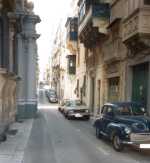 Look at the picture of a narrow street
in Valletta. The blue car in the foreground is a Morris Minor, and if I
remember rightly, the model with the divided windscreen ceased production
about 1948. (The Volvo behind it isn't exactly new, either.) Malta is a great
place if you want to buy a post WW II vintage English car. Ford Anglias, Triumph
Heralds, Morris Minors, Minis, you name it. I even saw the version of the
Singer Gazelle with twin head lights. I don't suppose there's one of those on
the road in the UK now. They're all still goers, and I dare say, some of them
are even road-legal. Not that I'm suggesting Maltese taxis were built in the
late 40's, some are quite modern, err, say mid 60's at least. Seriously,
most taxis are pretty new, a year or two old maybe and still roadworthy - or
at least those that haven't met a bus yet. No, most Maltese taxis are definitely not
like the crumbling Lada cab that tried to take us from Ta'Qali to Valletta. Look at the picture of a narrow street
in Valletta. The blue car in the foreground is a Morris Minor, and if I
remember rightly, the model with the divided windscreen ceased production
about 1948. (The Volvo behind it isn't exactly new, either.) Malta is a great
place if you want to buy a post WW II vintage English car. Ford Anglias, Triumph
Heralds, Morris Minors, Minis, you name it. I even saw the version of the
Singer Gazelle with twin head lights. I don't suppose there's one of those on
the road in the UK now. They're all still goers, and I dare say, some of them
are even road-legal. Not that I'm suggesting Maltese taxis were built in the
late 40's, some are quite modern, err, say mid 60's at least. Seriously,
most taxis are pretty new, a year or two old maybe and still roadworthy - or
at least those that haven't met a bus yet. No, most Maltese taxis are definitely not
like the crumbling Lada cab that tried to take us from Ta'Qali to Valletta.
Take a Bus
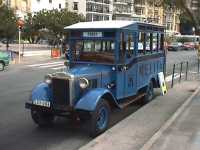 The
buses. Oh joy! (And this from a person who's managed to avoid riding a London
bus for 20 years!) One of the tourist leaflets bangs on about the buses, tells how
many there are (a lot) and how old they are (the oldest is 1918). It looks
like sometime in the 60's, an enterprising person dumped a load of Bedford
truck chassis down near the shipyards, and someone with a few tons of steel
plate 'left over' from repairing British naval shipping turned the trucks into
buses. They're yellow, they're are built like tanks, they have the road
holding properties and aerodynamics of the average house brick and they are
driven by maniacs who know who is going to win if someone gets in their way. There are also some more The
buses. Oh joy! (And this from a person who's managed to avoid riding a London
bus for 20 years!) One of the tourist leaflets bangs on about the buses, tells how
many there are (a lot) and how old they are (the oldest is 1918). It looks
like sometime in the 60's, an enterprising person dumped a load of Bedford
truck chassis down near the shipyards, and someone with a few tons of steel
plate 'left over' from repairing British naval shipping turned the trucks into
buses. They're yellow, they're are built like tanks, they have the road
holding properties and aerodynamics of the average house brick and they are
driven by maniacs who know who is going to win if someone gets in their way. There are also some more
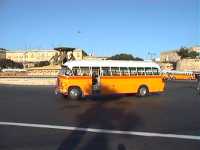 modern coaches. These look
pretty beaten up, as I guess they've had some arguments with the yellow tanks
- and lost. The inside of the tanks is less reassuring than the outside. Malta is a strongly Catholic country and the
driver's area is
usually covered with various religious blessings and icons. This is even more
worrying when you try to translate some of the Latin inscriptions - words like
'safe arrival', 'divine protection' and 'deliverance from death' feature
heavily. Then the driver gets on board, and 'crosses' himself before starting
the engine. All this, and the bus hasn't moved yet. modern coaches. These look
pretty beaten up, as I guess they've had some arguments with the yellow tanks
- and lost. The inside of the tanks is less reassuring than the outside. Malta is a strongly Catholic country and the
driver's area is
usually covered with various religious blessings and icons. This is even more
worrying when you try to translate some of the Latin inscriptions - words like
'safe arrival', 'divine protection' and 'deliverance from death' feature
heavily. Then the driver gets on board, and 'crosses' himself before starting
the engine. All this, and the bus hasn't moved yet.
Maltese buses have an affinity for each other, they collect in large flocks
at the
bus station just outside Valletta. Dozens of them (maybe up to a hundred
during rush hour), 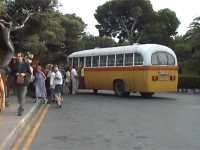 all going to places around
the island. Fares are cheap and there are only three 'fare zones'. Don't get
ripped off by the Express buses though. These supposedly go to the more far
flung ends of the island before stopping to set down and pick up passengers.
Fine in theory, but as town streets are narrow, these usually get stuck behind
regular buses picking up and setting down at will. Also, when the opportunity
arises, all Maltese bus drivers drive like Grand Prix drivers, so no
Express bus stands a chance of getting past a regular bus on the open road. all going to places around
the island. Fares are cheap and there are only three 'fare zones'. Don't get
ripped off by the Express buses though. These supposedly go to the more far
flung ends of the island before stopping to set down and pick up passengers.
Fine in theory, but as town streets are narrow, these usually get stuck behind
regular buses picking up and setting down at will. Also, when the opportunity
arises, all Maltese bus drivers drive like Grand Prix drivers, so no
Express bus stands a chance of getting past a regular bus on the open road.
Once away from Valletta, and having arrived at their destinations, buses
lurk in or near the village square. The drivers are nowhere to be seen. It's
no use thinking you'll board one to get out of the sun, the driver has
removed the route number, so you've no idea if it's the right bus, and if
there's more than one of them, which is leaving first. So you join a gaggle of
locals and fed up tourists all hanging around within sprinting distance of the
buses, in sight of where the route numbers will be displayed. Then a driver
appears - no-one moves - until he's poked about in his cardboard box and
produced the numbers, then the little game, is it going to be a 36 or a 93 -
particularly sadistic drivers will start the engine for a quick get away,
before displaying the numbers. Then the mad dash to get on board. It's
surprising how fast little old ladies can move, and you'd swear they breed especially
sharp elbows in Maltese villages. Heaven help you if you haven't got the right
change, you'll probably be trampled to death by a herd of little old ladies
all dressed in black.
Churches
 Almost
all places you visit involve churches. It's said (another tourist leaflet, I
think) that
Malta has 365 churches, one for each day of the year - you can believe it! All
are large, and some are spectacularly ornate. Some are so close to each other,
that you wonder, "What's the point?" Two are well known and on every
tourist trip. The parish church at Mosta is Cathedral size, Almost
all places you visit involve churches. It's said (another tourist leaflet, I
think) that
Malta has 365 churches, one for each day of the year - you can believe it! All
are large, and some are spectacularly ornate. Some are so close to each other,
that you wonder, "What's the point?" Two are well known and on every
tourist trip. The parish church at Mosta is Cathedral size,
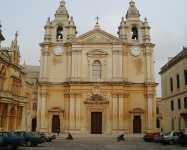 and
has one of the largest unsupported domes in the world. But it's only the
parish church of a small village. The other is the
Cathedral Church
in the Walled City of Mdina. You won't believe that marble comes in so many
colours. Notice the twin towers and two clocks. A common feature of most
Maltese churches. One clock tells the correct time, the other is always wrong.
Something about confusing the devil - but if I can work it out, I'm sure Old
Nick can! and
has one of the largest unsupported domes in the world. But it's only the
parish church of a small village. The other is the
Cathedral Church
in the Walled City of Mdina. You won't believe that marble comes in so many
colours. Notice the twin towers and two clocks. A common feature of most
Maltese churches. One clock tells the correct time, the other is always wrong.
Something about confusing the devil - but if I can work it out, I'm sure Old
Nick can!
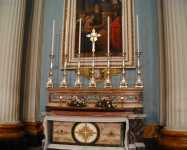 The
Mosta parish church had a narrow escape during the war. A 250 Kg bomb came through the dome during
Mass - and failed to explode. Had it done so, there wouldn't have been much
left of the church or the population of Mosta. A replica of the bomb is on
show round the back. It's an odd world, some churches have bits of dead saint
as relics, this one has a lump of German munitions instead. Being almost
circular, the church has altars The
Mosta parish church had a narrow escape during the war. A 250 Kg bomb came through the dome during
Mass - and failed to explode. Had it done so, there wouldn't have been much
left of the church or the population of Mosta. A replica of the bomb is on
show round the back. It's an odd world, some churches have bits of dead saint
as relics, this one has a lump of German munitions instead. Being almost
circular, the church has altars 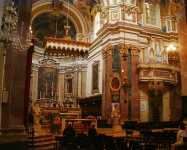 spread round the
periphery and seating in the centre - different. Make sure you've
checked the opening times. The priests
like a long siesta and the churches are usually closed between 12 and 3. There
isn't a lot to do in Mosta if you turn up when it's shut. spread round the
periphery and seating in the centre - different. Make sure you've
checked the opening times. The priests
like a long siesta and the churches are usually closed between 12 and 3. There
isn't a lot to do in Mosta if you turn up when it's shut.
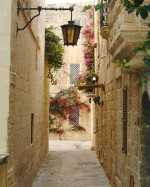 Mdina, on the other hand is a complete self contained city, so if the
Cathedral isn't open, there's a lot else to explore. Lots of narrow streets,
ancient buildings, a couple of nice restaurants, another place to spend a half
day getting just the feel of the place. Back to the Cathedral, this really is
a Cathedral, big, spacious, peaceful and ornate. Deep red and gold being the predominant
colours. Mdina, on the other hand is a complete self contained city, so if the
Cathedral isn't open, there's a lot else to explore. Lots of narrow streets,
ancient buildings, a couple of nice restaurants, another place to spend a half
day getting just the feel of the place. Back to the Cathedral, this really is
a Cathedral, big, spacious, peaceful and ornate. Deep red and gold being the predominant
colours.
As I've said, there's churches everywhere, even the tiniest hamlet has a
church that would be more suited to a city. No expense is spared, and I can't
help wondering if the money wouldn't be better spent elsewhere. Anyway, for
good measure here are three more.
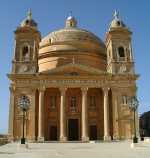 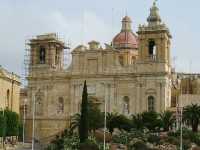 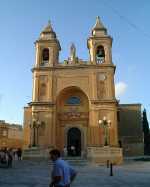
As
well as the churches, there are the religious places. Perhaps not so many as
churches, but a fair smattering around the island. St. Paul's Grotto attracts
a fair number of visitors, and is well looked after. A cave, and a pleasant
little garden for a few moments of meditation. Why St. Paul should pick this
place is hard to imagine, it's in the middle of nowhere. Well not entirely
true as no-place is too far from anywhere else on the island. But it's still
about as far away from anywhere as is possible to get.
Malta's religious history goes back well 'Before Christ', in the south of
the island are pre-historic stone temples. No-one is quite sure who put them there,
but they were there when we English got round to building Stonehenge. Malta
has a companion island, Gozo, and that has the oldest stone age temples in the
world - so it says two things - Malta has been inhabited for a long time, and
religion has featured throughout their history.
So There's Churches and Grottos, What Else?
Enough for everyone. The St. Julian's area is for the young clubbers, it's
fairly quiet during the day, but as night falls, everyone emerges and it turns
into an all night party. Not my idea of a 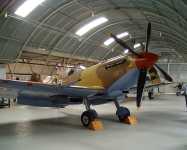 holiday,
but if that's what turns you on? The old air base at Ta'Qali has been
turned into a crafts centre. A great way of extracting money from tourists,
and extremely boring if you aren't interested in jewellery shops, potteries
and ornamental glass works. But, tucked round the back is the Ta'Qali air
museum. Not big, but right up my street. They've got some nice exhibits and
are busily rebuilding some real wrecks. They've also uncovered a couple of sad
stories, for instance, they've rescued the Spitfire that took off one evening
on a wartime patrol and wasn't seen again until they dredged it up 50 years
later, 20 miles out to sea. They think the pilot got lost in the dark, ran out of gas and
crashed into the drink. holiday,
but if that's what turns you on? The old air base at Ta'Qali has been
turned into a crafts centre. A great way of extracting money from tourists,
and extremely boring if you aren't interested in jewellery shops, potteries
and ornamental glass works. But, tucked round the back is the Ta'Qali air
museum. Not big, but right up my street. They've got some nice exhibits and
are busily rebuilding some real wrecks. They've also uncovered a couple of sad
stories, for instance, they've rescued the Spitfire that took off one evening
on a wartime patrol and wasn't seen again until they dredged it up 50 years
later, 20 miles out to sea. They think the pilot got lost in the dark, ran out of gas and
crashed into the drink.
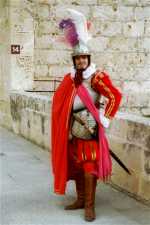 Fort
St. Elmo is at the far end of Valletta. It is a fort, you know, stone
walls, battlements, etc., and just to prove it, every now and then you get
treated to the local equivalent of the Sealed Knot Society re-enacting some
famous battle or other. Great to watch, and pretty noisy. You might get lucky,
as they do seem rather enthusiastic when it comes to filling the canons with
black powder. One of these days, one of these relics is going to go off rather
more spectacularly than expected. Just make sure you're out of the shrapnel
line. The knights of St. John are also mixed up in there somewhere. Fort
St. Elmo is at the far end of Valletta. It is a fort, you know, stone
walls, battlements, etc., and just to prove it, every now and then you get
treated to the local equivalent of the Sealed Knot Society re-enacting some
famous battle or other. Great to watch, and pretty noisy. You might get lucky,
as they do seem rather enthusiastic when it comes to filling the canons with
black powder. One of these days, one of these relics is going to go off rather
more spectacularly than expected. Just make sure you're out of the shrapnel
line. The knights of St. John are also mixed up in there somewhere. 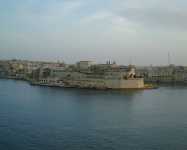 Then
Napoleon and the French and Nelson and the English. It's all very complicated,
so studying a potted history before you go might be a bright idea. Then
Napoleon and the French and Nelson and the English. It's all very complicated,
so studying a potted history before you go might be a bright idea.
There's also the sea. Malta has always lived on the profits of the sea. It
used to be fishing, but these days, Malta's dry dock and ship fitting
facilities in the Grand Harbour add considerably to the national income.
There's still a lot of small fishing boats around, and a trip to 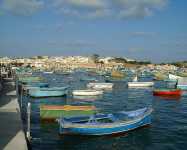 Marsaxlokk Harbour
is a must for photographers. Maltese boats have eyes painted on them - to ward
off evil spirits, and the whole of the harbour is full of them - boats that
is. Go on a Sunday, as it has a pretty good street market used by the locals.
The 'hand-made' Maltese lace on sale is mostly imported machine made tat for
the tourist market. But you can find bargains if you look. If you go during
the week, there's Marsaxlokk Harbour
is a must for photographers. Maltese boats have eyes painted on them - to ward
off evil spirits, and the whole of the harbour is full of them - boats that
is. Go on a Sunday, as it has a pretty good street market used by the locals.
The 'hand-made' Maltese lace on sale is mostly imported machine made tat for
the tourist market. But you can find bargains if you look. If you go during
the week, there's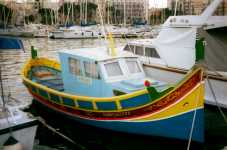 a couple of cafes and a restaurant or two, but not a lot else - well the
parish church is worth a look round, but nothing that special.
a couple of cafes and a restaurant or two, but not a lot else - well the
parish church is worth a look round, but nothing that special.
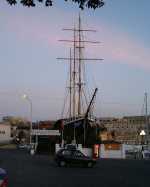 Oh,
and the rabbits? The local rabbits breed like - err - rabbits, and during the
war there wasn't a lot else to eat on the island. So during the siege, rabbits
became rather important. These days, rabbits are revered, as one of the
saviours of the island, so if a hotel is built on a rabbit warren, what else
do you call the hotel? Oh,
and the rabbits? The local rabbits breed like - err - rabbits, and during the
war there wasn't a lot else to eat on the island. So during the siege, rabbits
became rather important. These days, rabbits are revered, as one of the
saviours of the island, so if a hotel is built on a rabbit warren, what else
do you call the hotel?
And
so the week comes to an end. Goodbye to the hotel - even the bar and wine bill
was a pleasant surprise - about half of what I'd guessed. The airport was
quietly efficient, and the flight back to the UK uneventful. As we fly in,
it's apparent that there's still some flooding about, but the south of England
seems a lot less soggy than it was when we left.
Malta is definitely on my 'visit again' list. There's still plenty I
haven't seen, and much I'd like to re-visit. The weather in November was just as I like
it, sunny, warm and dry but definitely not hot. It's populated by nice friendly people, who
speak English
and the whole place is busy but not overcrowded at that time of year. However, I think I'll make my next
visit about the same time of the year, I really don't fancy this end of Med in
mid summer - too many tourists and too hot!
 Updated
01/10/03 Updated
01/10/03
|